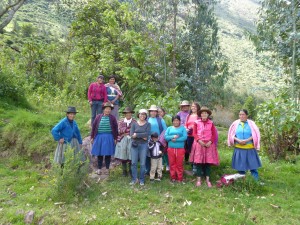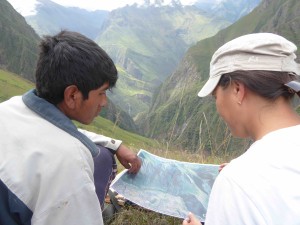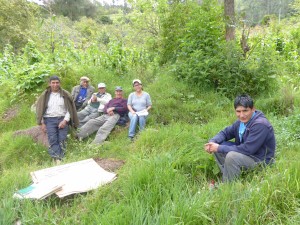Comparing agroforestry practices as options for adaptation to climate change from the perspective of smallholders in the Peruvian Andes
by Sarah-Lan Mathez-Stiefel
Background:
 The Andean region of Peru is highly vulnerable to the impacts of climate change. Climate models predict significant increases in temperature, leading to increased glacier melt, with implications for water supply and regulation in both Andean and coastal zones. Furthermore, the Peruvian Andes are highly susceptible to natural catastrophes related to climatic extremes, particularly flooding, which affect predominantly the rural Andean population that lives below the national poverty line.
The Andean region of Peru is highly vulnerable to the impacts of climate change. Climate models predict significant increases in temperature, leading to increased glacier melt, with implications for water supply and regulation in both Andean and coastal zones. Furthermore, the Peruvian Andes are highly susceptible to natural catastrophes related to climatic extremes, particularly flooding, which affect predominantly the rural Andean population that lives below the national poverty line.
Agroforestry is a practice with a long history in the Andes, and is currently seen as a promising tool for sustainable land management and climate change adaptation but there is little published research about it. A diversity of agroforestry practices currently co-exist in Andean landscapes, however, there is an urgent need for critical examination of such practices in the context of climate change adaptation. Not only should agroforestry practices as options for climate change adaptation be compatible with local livelihoods, but they should also build on local knowledge. This is especially true in the Andes, where local people have developed complex knowledge system and coping strategies in a context of extreme climatic conditions and high climate variability.
Research objectives
The main objective of this research project is to compare different agroforestry practices as options for climate change adaptation in the Andes, by determining the benefits of trees in rural landscapes from the perspective of smallholder women and men.
The research involves three indigenous communities, mostly Quechua-speaking of Chanka and Inca origins located in the valley of the Apurimac River in the Southern Peruvian Andes. The site covers an altitude range from 2000 metres up to 3800 metres, which means that there is a diversity of farming practices, ecological habitats, land use and livelihoods systems, and thus also of farming practices being studied.
 The specific objectives of the research are to:
The specific objectives of the research are to:
- Get an historical overview of the presence and management of native and exotic trees at the research site at the landscape level.
- Identify current agroforestry practices existing at the research site and their integration within local livelihoods and land use systems.
- Document local women and men’s ecological knowledge on agroforestry practices, and their contribution to climate change adaptation.
- Investigate women and men’s appreciation of the ecological, economic, and socio-cultural benefits of different agroforestry practices in the context of a changing environment.
- Develop locally-adapted and gender-sensitive recommendations for the promotion of agroforestry as a climate change adaptation strategy in the Andes.
The study is being done within a partnership with the Andean Forests Programme on Climate Change, financed by the Swiss Agency for Development and Cooperation. The results of the study will inform the program’s efforts and activities to improve capacities for climate change adaptation and mitigation in the region through the consolidation and up-scaling of successful incentive policies, practices, tools and frameworks, for the sustainable management of Andean forests.
Methodology:
The research applies a transdisciplinary approach that involves the use of interdisciplinary and participatory tools. A combination of ethnographical (participant observation, in-depth interviews), ethnobotanical (inventories, preference ranking), and participatory tools for gender research in climate change and agroforestry are being applied for data collection.
 All data is sex-disaggregated and analyzed with a gender focus to consider gender differences in the knowledge and valuation of agroforestry species, practices and forest resources.
All data is sex-disaggregated and analyzed with a gender focus to consider gender differences in the knowledge and valuation of agroforestry species, practices and forest resources.
The study is using tested tools such as: the Agroecological Knowledge Toolkit (AKT5) to explore local agroecological knowledge on agroforestry practices; the Rapid Appraisal of Agroforestry Practices, Systems and Technologies (RAFT) for an inventory of agroforestry practices; the Gender & Inclusion Toolbox to explore perceptions of social-ecological change; and the guide In Equal Measure: a User guide for gender analysis in Agroforestry to identify gender perceptions of benefits of agroforestry practices.
Preliminary findings:
The study’s preliminary findings show that Andean farmers have important knowledge on the buffering role of shrubs and trees for increased temperatures and soil and water conservation, including erosion control, promotion of soil fertility, and the management of increasingly scarce resources. However, their knowledge is more limited regarding species that can protect their productive systems against extreme climatic events such as heavy rainfalls, hail, and strong winds. While no significant differences were found between the agroecological knowledge of men and women, their valuation of agroforestry practices vary greatly. Men give more importance to the direct uses of agroforestry practices, such as the provision of food or income, and women value more socio-cultural benefits such as the delimitation of the territory and esthetic values. Both value equally the ecological benefits of agroforestry practices.











